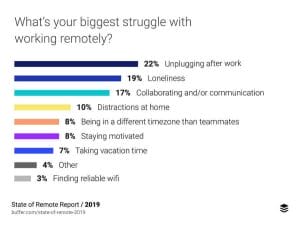
Performance management is a challenge for many working professionals who manage their own teams and that's when everybody is at the office! Having to deal with poor employee performance while trying to run a completely remote team is even harder.
While it can be tempting to avoid such a difficult situation, the alternative could cause irreparable damage: underachieving not only causes deadlines to be missed but it has a ripple effect of negativity, low morale and poor quality of work as a team too.
To approach performance management in the right manner, here are 14 ways that you can deal with poor employee performance.
You first need to know the challenges of working remotely
When it comes to underperformance, it can be easy to assume it's due to procrastination or laziness. However, when you look deeper, you may find that the reason for this low performance may be due to the other challenges that come from working remotely.
According to Buffer's State of Remote Work report, among the top major challenges of remote working is:
-
- Loneliness (19%)
- Collaborating/communication issues (17%)
- Distractions at home (10%)

Once you're aware of these challenges that face remote workers, it makes sense that you can then implement the right measures to address these issues. For example, prolonged isolation can, in extreme cases, result in anxiety and depression and this is only exacerbated by the communication-related challenges that remote working brings.
To overcome this challenge, you need to think about how you can communicate more easily and effectively. How can you check in on people to make sure that their wellbeing is intact? Would it be beneficial to have regular video calls as a team or perhaps it would be better to create an instant messaging group chat where everyone can give daily work and personal updates?
As a team leader, it is your responsibility to be aware of these challenges and to take the steps necessary to improve engagement, productivity, and cohesion across your entire team. Remote working can cause a breakdown in trust and collaboration if left unaddressed and with the current social distancing measures still going on, the lack of interaction can really impact our health and performance. Be aware of this.
Useful resources:
How to deal with poor employee performance
Here are 14 ways to deal with poor employee performance while managing your remote team. You may only need to use one or two of these if you're aware of the certain challenges that your employees are facing or you may benefit from implementing a mixture of these methods. Find what works best for you and your team.
1) Look to yourself first
Could your employees be underperforming because of something that you're doing or not doing? Before pointing the finger towards them, give your management a brutal review first. It could be that you're not giving clear instructions or proper work briefs. It could be that they don't know what your expectations are or the repercussions of underperforming. Be clear, specific, and concise about what you want and expect from your employees.
2) Communicate often and effectively
Communication is a challenge when working remotely, especially in a high-stress situation like the one we find ourselves in. As face-to-face communication is few and far between, it can become difficult to sense intent in messages between you and your employee so there could be some misunderstandings. To combat this, schedule more video calls and pick up the phone regularly! It builds trust and rapport, it saves misunderstandings and it quickly helps everyone to move forward aligned and motivated. It would also be very beneficial to put together a remote communication strategy (e.g. decide on the number of weekly formal "report-ins," set guidelines about daily needs, and set clear task priorities).(Discover the how to run effective online meetings)
3) Monitor your employee's performance over a period of time
If you've noticed a slacking of performance with someone in your team, take note and start paying attention to this over the next week or two. If it's evident that they haven't just had a bad day, gather a few examples of where they've underperformed so that you can discuss these when you speak to them.(Read 7 ways to make sure your remote employees are actually working)
4) Be specific when you have that conversation
When you approach your employee about their performance, make sure you have your specific examples to show them exactly where the performance issue lies. Make sure you don't use harsh phrases that may reduce their self-esteem. The aim here is to bring this to their attention and to help them rectify it. Be direct and precise when you set your expectations and leave no room for misinterpretation.
5) Deal with poor employee performance as soon as possible
As soon as underperformance comes to your attention and you've monitored it to be sure that it's consistent, deal with the issue immediately. You need to show your employee and the rest of the team that underperformance is not acceptable. If you don't, then you'll set a bad precedent for remote working moving forward.
6) Consider the needs of your employees (especially now)
Remote working brings different kinds of distractions and challenges, and with the current global crisis, many of us are trying to juggle relationships and family life with working from home. While it can be easy to assume laziness when it comes to underperformance, you should check in with your employee first. It may be the result of a bigger issue such as a child being ill or their mental health is suffering. When you know the reason, you can then address their needs directly and offer help for them to get back on track.(Discover 3 ways to look after your staff's wellbeing during COVID-19)
7) Provide more support or training if necessary
Not all employees would have worked remotely before and some may not be confident in using certain software or apps. Check if they need any additional support, training or coaching for this. This is a great way to help them improve without making them feel like they are doing a bad job! You can provide this to your employee over Zoom or you can buddy them up with a high-performing employee to act as their mentor. You can also introduce them to performance improvement tools such as Walkme which can help them become more efficient.
8) Understand what motivates your employees as individuals
It's hard to manage people when you don't know what motivates them so get to know your employees. You should take some time to ask them about their long-term goals and aspirations, where they would like to see their career heading in the next 12-months, and how you can support them. To get the best out of your employees while they work from home, first understand their why. When you know this, you can delegate the right work and tasks and they'll be far more motivated with your full support behind them.
9) Show where they fit in the overall mission
This is an important point anyway but even more so with the current situation. The global pandemic and social distancing measures have fostered feelings of helplessness as many of us have lost control over many aspects of our lives. Make a point of explaining to your employees where they fit in 'the big picture' and how their work fits in with the team and how it affects the business as a whole. If they feel like an integral part of the business, engagement and performance will be much higher.
10) Ask them to review your performance
A great way to deal with poor employee performance is to ask your employee to review you as their manager. How can you help them to perform better? This technique is far less confrontational and it allows the employee to open up and think about what they think they need. Once you have the areas that you need to work on as the manager, you can then touch on a few things that you need from them.
11) Create their performance goals with them
To tackle low performance, get the employee involved in creating their own performance goals. This encourages them to 'opt-in' to their goals rather than you simply dictating what is expected so you'll soon see a change in performance. Ask them how they would like to improve, what they would like to achieve, and how you can both work together to prevent any performance issues in future.
12) Monitor their performance and focus on feedback
After they've been made aware that their performance has been lacking, make sure to regularly check their progress and follow up with them to give constructive feedback. Weekly or monthly feedback will provide much-needed structure and accountability for your remote employees, so praise where necessary and give extra support where it's needed.
13) Offer rewards and recognition
People love recognition, it's an essential part of 'the carrot and the stick approach,' so reward progress regularly. During this stressful period, surrounded by all this negativity, we can all do with being appreciated so celebrate the smallest of team efforts too. When you reward efforts and recognise great work, your employees will feel appreciated and valued and in turn, will perform better. A great way to implement this is to reward the best performer of the week or month.
14) Act on continued underperformance
If the carrot isn't working and extra support and feedback hasn't done the trick, you need to give your underperforming employee a final warning. This not only shows them how serious you are about underperformance, but it also shows the rest of the team that you don't tolerate it either. If you have tried all of the above and no improvements or progress has been made, it may be time to let that person go. This is never ideal and should always be treated as a last resort, but sometimes it may be necessary for your business.
Address underperformance in the right way
While performance management isn't easy, it's essential that you deal with poor employee performance as soon as you can. The last thing you need when trying to manage a team remotely is your hard working members becoming disengaged when they see others slacking off without any repercussions, so nip it in the bud. Using these 14 methods, stay on top of your performance management and start to deal with poor employee performance in the most effective way.





